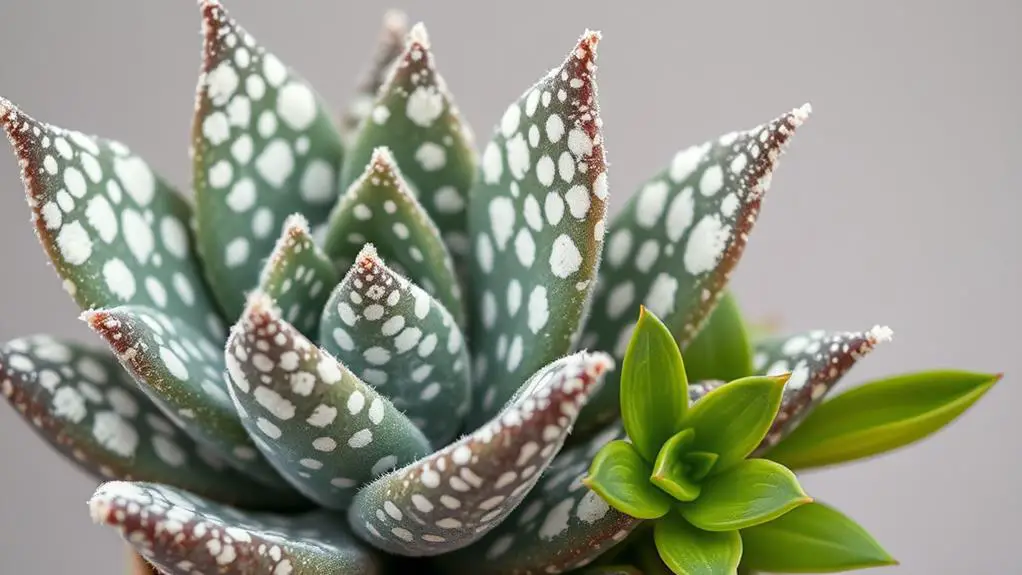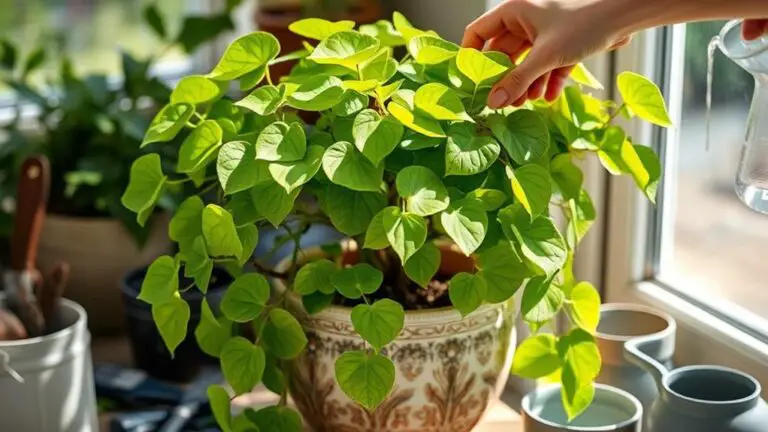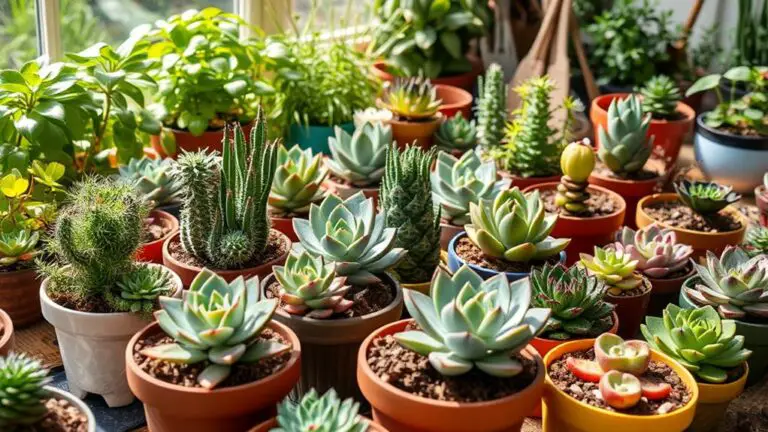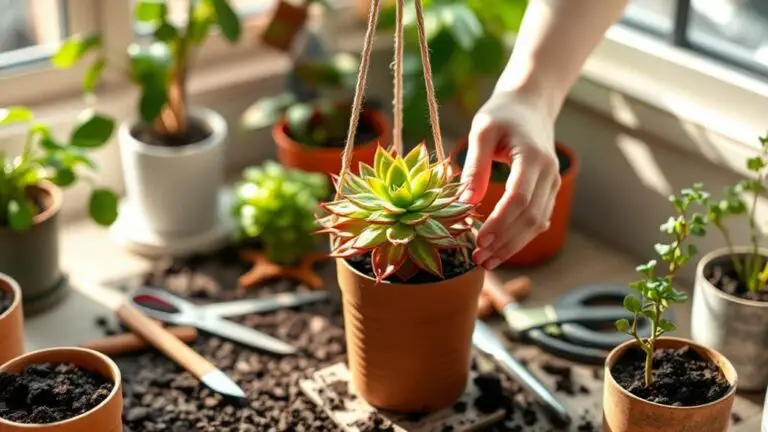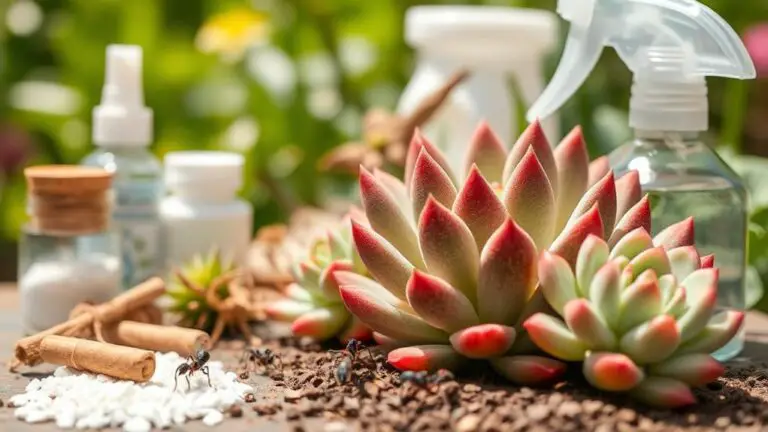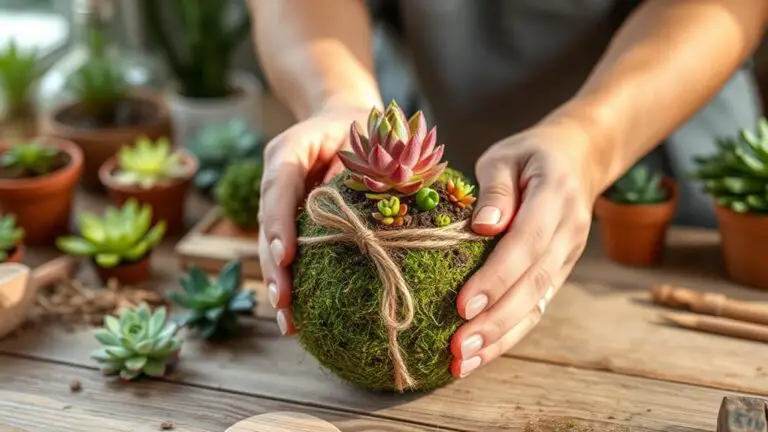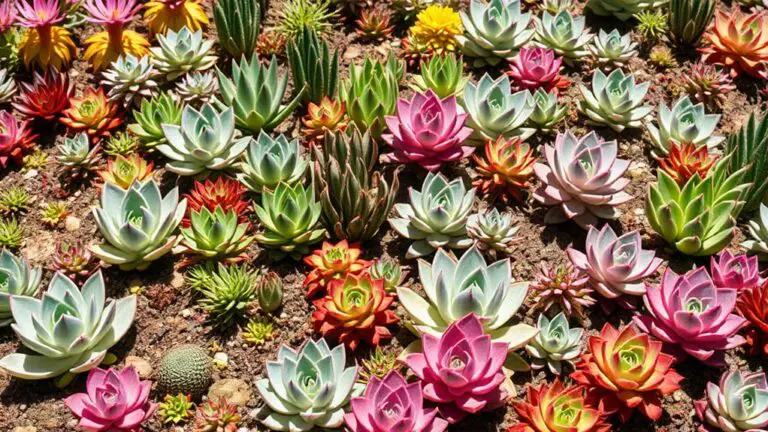Why Are There White Spots on My Succulents?
Have you noticed white spots on your succulents and wondered what's going on? These spots could be a sign of various issues, from powdery mildew to pesky mealybugs, or even just a buildup of salt. Each cause requires a different approach to fix, so identifying the problem early is essential. You might think it's just a cosmetic issue, but these spots can actually signal bigger health concerns for your plants. Curious about how to diagnose and treat these white spots effectively? Let's explore the possible causes and solutions together.
Powdery Mildew
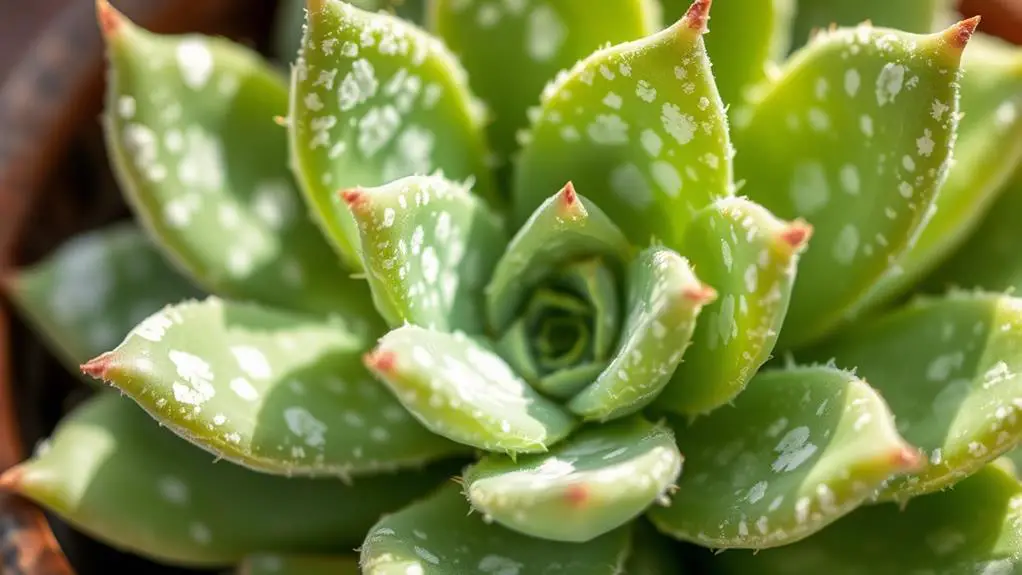
Powdery mildew is a common fungal infection that can plague your succulents, especially in warm, dry environments.
You'll notice white spots on your succulent leaves, which can spread if left untreated. This fungal infection starts small but can quickly worsen, turning spots dark, brown, or even black.
To combat this, start by pruning infected leaves and applying copper fungicides. These steps help manage and eliminate the infection.
Preventive measures are essential. Guarantee good air circulation, avoid overcrowding your plants, and monitor humidity levels to keep powdery mildew at bay.
Pests
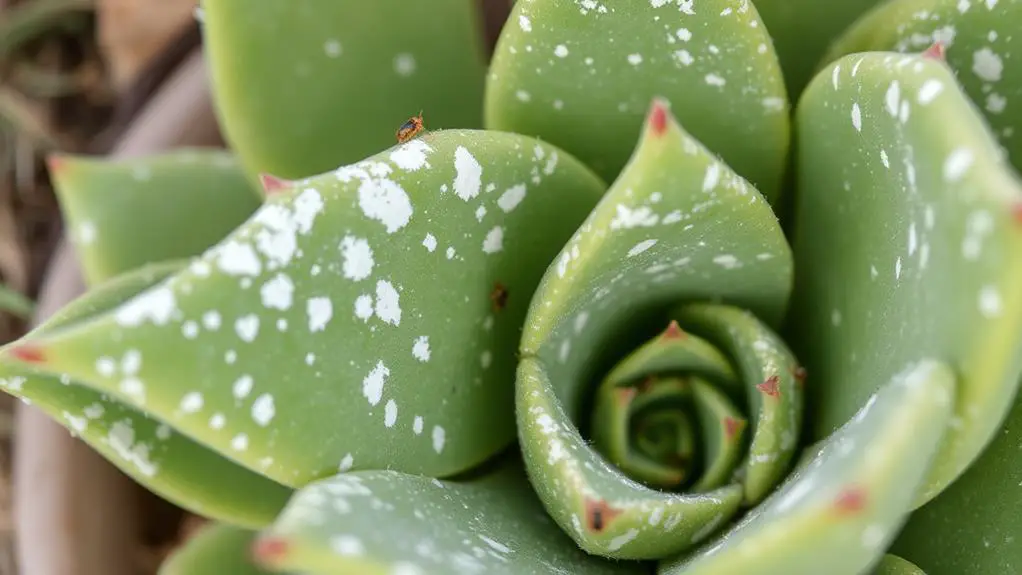
While fungal infections like powdery mildew pose a significant threat to succulents, pests are another formidable challenge you might face.
Mealybugs, which appear as white cottony spots, are common pests that can cause severe damage by feeding on plant sap. Infestations often begin near new growth, causing misshapen or deformed leaves. Overwatering can make your succulents more susceptible, so maintaining proper watering practices is vital.
To manage mealybug infestations, try these steps:
- Manual removal: Use alcohol-soaked cotton swabs to eliminate visible mealybugs.
- Insecticidal soap: Apply to infested areas for effective pest control.
- Neem oil: Use as a natural treatment option.
- Regular inspections: Check your plants frequently and guarantee adequate airflow to catch and reduce infestations early.
Keeping these practices in mind will help you maintain healthy, pest-free succulents.
Too Much Salt
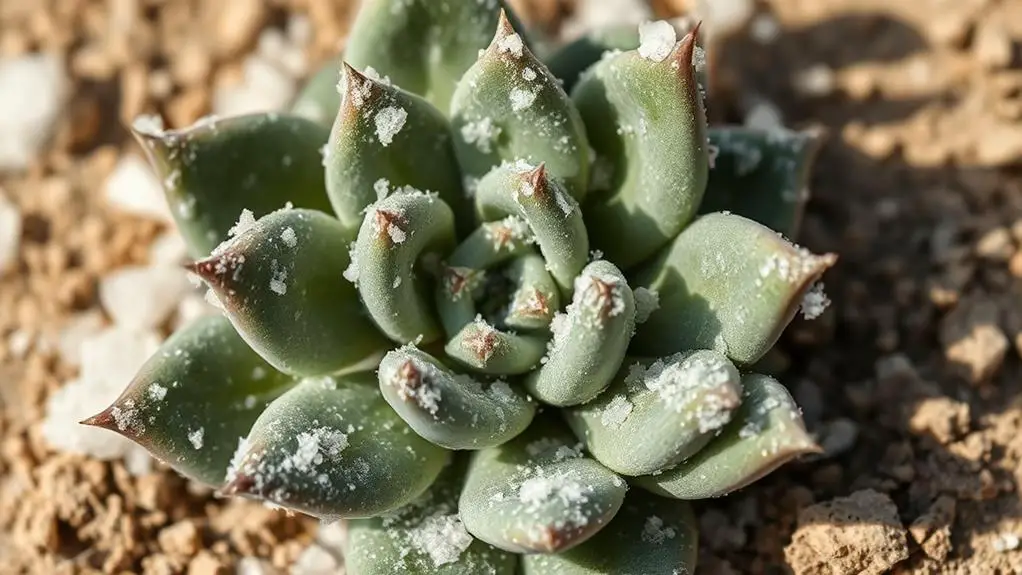
Too much salt in your succulents' soil can wreak havoc on their health and appearance.
When salt buildup happens, usually from hard water or over-fertilization, you might notice white spots or visible rings at the plant's base. These salts can cause crusty deposits on pots and splotchy patches on leaves, hurting your succulent's health by absorbing moisture and impairing water uptake.
To counter this, use distilled water for watering and rinse the soil every 4-6 months to flush out salts. Avoid over-fertilization to keep soil health in check.
Following these steps will help you maintain a healthy, beautiful succulent without those pesky white spots. You're doing great—keep at it!
Edema
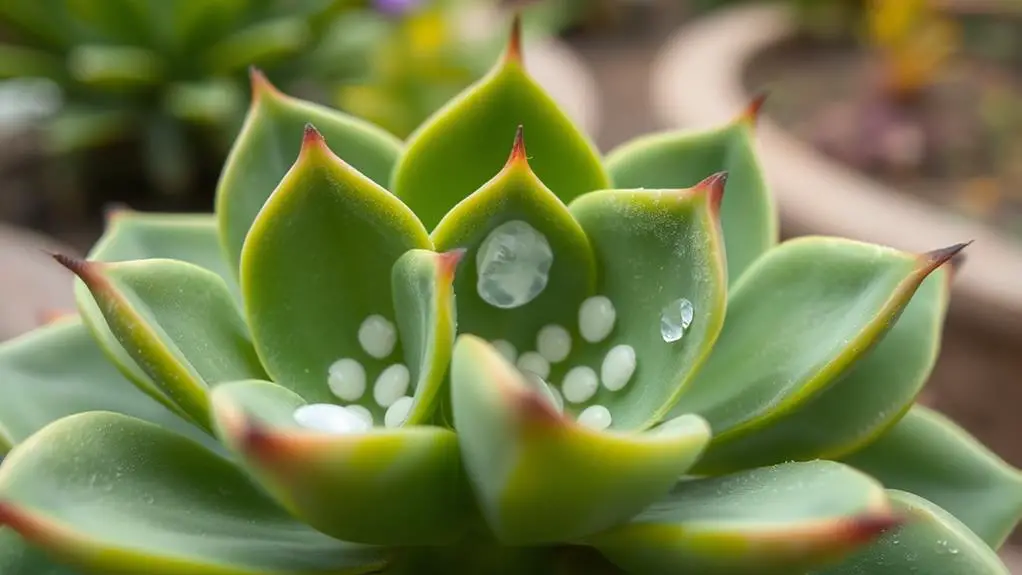
If you've noticed welts or blisters forming on your succulent's leaves, edema might be the culprit. This condition happens when your succulent absorbs more water than it can hold, causing its cells to rupture.
Edema is often a result of overwatering and can be made worse by high humidity or low light conditions.
To manage edema, follow these steps:
- Repot your succulent in well-draining soil to prevent water from pooling around the roots.
- Allow the soil to dry out completely before watering again, reducing the risk of overwatering.
- Increase light exposure to help the plant use up water more efficiently.
- Monitor humidity levels and maintain proper air circulation to reduce moisture stress.
Proper care can prevent edema and keep your succulent healthy.
Succulent Farina
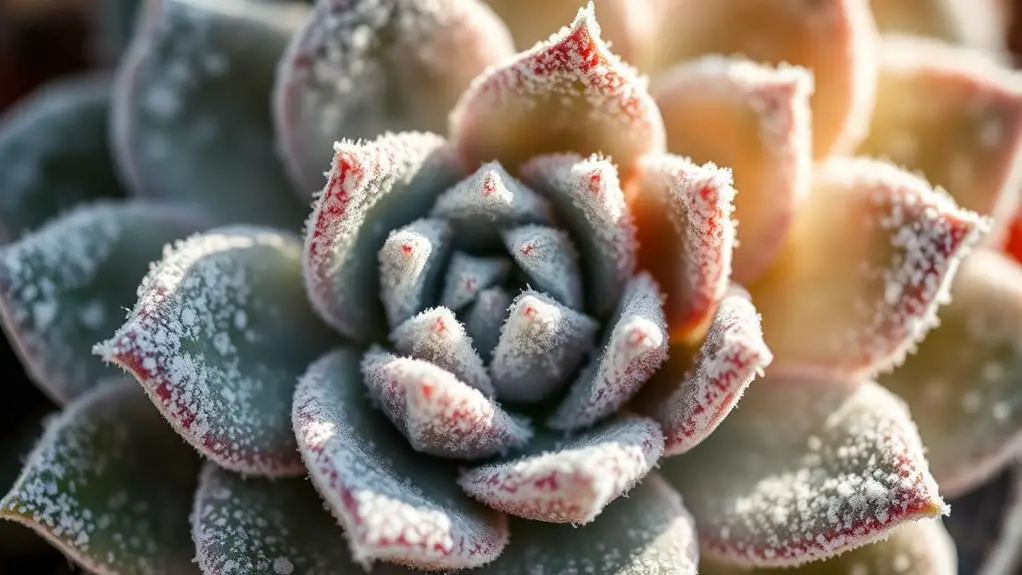
Succulent farina, that thin, powdery coating you often see on species like Echeveria and Kalanchoe, is more than just a cosmetic feature. This natural waxy layer acts as a protective barrier against sunburn and water loss. The white spots you see are actually farina, appearing as a translucent, grayish dust on the leaves.
| Species | Common Name | Farina Color |
|---|---|---|
| Echeveria | Hen and Chicks | White/Gray |
| Sedeveria | Lilac Mist | White/Gray |
| Kalanchoe | Panda Plant | White/Gray |
Farina helps reflect sunlight, reducing the risk of leaf scorching in intense light conditions. This harmless characteristic is vital for the plant's health and protection. Be careful not to wash it off during watering or cleaning, as it's essential for their care.
Frequently Asked Questions
How to Get Rid of White Spots on Succulents?
To get rid of white spots on your succulents, prune infected leaves, apply a copper fungicide or a baking soda mixture, remove mealybugs with alcohol, use hydrogen peroxide for fungi, and adjust watering practices.
Why Is My Succulent Growing White Stuff?
Your succulent's growing white stuff likely due to powdery mildew, mealybugs, or salt buildup. Inspect your plant closely to identify the issue, then adjust watering habits, improve air circulation, and consider treatment options to resolve the problem.
How Do You Treat White Powdery Mildew on Succulents?
You can treat white powdery mildew on succulents by pruning affected leaves and applying a copper fungicide or a baking soda solution. Guarantee proper watering, let soil dry out completely, and maintain good airflow to prevent recurrence.
Why Is My Succulent Turning White?
Your succulent's turning white could be due to powdery mildew, mealybugs, excess salt buildup, or natural farina. Check for pests or environmental stressors, and guarantee proper watering and drainage to keep your plant healthy.
Conclusion
Taking care of your succulents can be a fun and rewarding experience. By identifying the cause of those white spots—whether it's powdery mildew, pests, too much salt, or even just natural farina—you'll be well-equipped to treat your plants and keep them healthy. Remember, a little attention goes a long way. Don't be discouraged; you've got this! Keep learning and soon your succulents will be thriving and beautiful again. Happy gardening!

